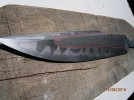HI GUYS
long time no see, well i just want to introduce you a knife that i made recently, is my just second knife in this style and i'm very satisfied how this knife come out, so let the story begin.
i took a leaf spring from the pile of the scrap steels, and i cut a large piece

here is in the forge, i cut a short tail to give sure catch to the tongs

the forging is allmost finish

here after rough grind the perimeter

bevels and fin are now rough grinded ( later i decided to go to hi grind)


after finishing grinding and polishing i decide to try for differential hardening and hamon if possible, first i cover the tottal blade with a very thin clay layer

after drying i decide to improvise a bit

holly crap!!!!! i allmost forgot to take the pic with the last clay layer on it!!! as we say late is better to never!!!

right after heat treat, did you see the funy face on the clay?

blade all cleaned up and polish ready for the acid etch, pheric chloride

and now let the fun begin!, look how she come out from the echant!!!!

and after some circles of etch and polish!!!! holy smoke!!!!


after thatis time for the handle making, the guard first,phosphor bronze

i'm going to use a block of judas tree, that i collected my own!

start shaping

handle ready, stunning beauty!!

and the knife is done!!

this one taken by the night and its quite blurr but i like the perspective!!

specifications
blade 11,4 in. from leaf spring
handle 5,5in. judas tree, phosphor bronze guard, brass pin
tottal 16,9in.
-------------------------------------------------------------------------------------------------
hope you like it, and any comment are wellcome( my apologies for the mesh in my shop)
long time no see, well i just want to introduce you a knife that i made recently, is my just second knife in this style and i'm very satisfied how this knife come out, so let the story begin.
i took a leaf spring from the pile of the scrap steels, and i cut a large piece

here is in the forge, i cut a short tail to give sure catch to the tongs

the forging is allmost finish

here after rough grind the perimeter

bevels and fin are now rough grinded ( later i decided to go to hi grind)


after finishing grinding and polishing i decide to try for differential hardening and hamon if possible, first i cover the tottal blade with a very thin clay layer

after drying i decide to improvise a bit

holly crap!!!!! i allmost forgot to take the pic with the last clay layer on it!!! as we say late is better to never!!!

right after heat treat, did you see the funy face on the clay?

blade all cleaned up and polish ready for the acid etch, pheric chloride

and now let the fun begin!, look how she come out from the echant!!!!

and after some circles of etch and polish!!!! holy smoke!!!!


after thatis time for the handle making, the guard first,phosphor bronze

i'm going to use a block of judas tree, that i collected my own!

start shaping

handle ready, stunning beauty!!

and the knife is done!!

this one taken by the night and its quite blurr but i like the perspective!!

specifications
blade 11,4 in. from leaf spring
handle 5,5in. judas tree, phosphor bronze guard, brass pin
tottal 16,9in.
-------------------------------------------------------------------------------------------------
hope you like it, and any comment are wellcome( my apologies for the mesh in my shop)
Last edited:




